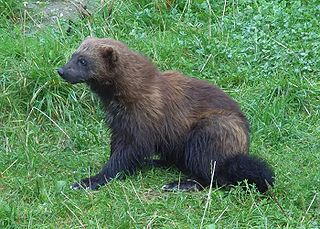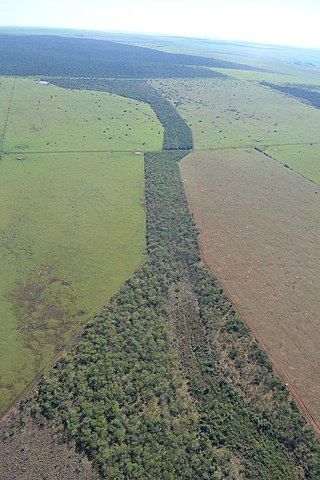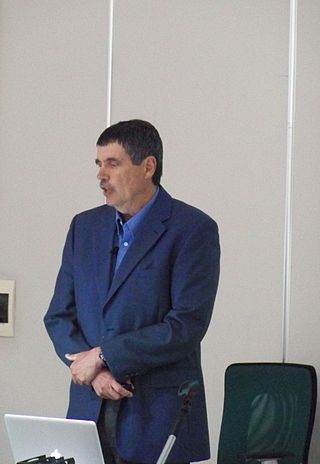
The coyote, also known as the American jackal, prairie wolf, or brush wolf, is a species of canine native to North America. It is smaller than its close relative, the gray wolf, and slightly smaller than the closely related eastern wolf and red wolf. It fills much of the same ecological niche as the golden jackal does in Eurasia; however, the coyote is generally larger.

The wolverine, also called the carcajou or quickhatch, is the largest land-dwelling member of the family Mustelidae. It is a muscular carnivore and a solitary animal. The wolverine has a reputation for ferocity and strength out of proportion to its size, with the documented ability to kill prey many times larger than itself.

The cougar, also known as the panther, mountain lion, catamount and puma, is a large cat native to the Americas. It inhabits North, Central and South America, making it the most widely distributed wild, terrestrial mammal in the Western Hemisphere, and one of the most widespread in the world. Its range spans the Yukon, British Columbia and Alberta provinces of Canada, the Rocky Mountains and areas in the western United States. Further south, its range extends through Mexico to the Amazon Rainforest and the southern Andes Mountains in Patagonia. It is an adaptable generalist species, occurring in most American habitat types. It prefers habitats with dense underbrush and rocky areas for stalking but also lives in open areas.

Conservation biology is the study of the conservation of nature and of Earth's biodiversity with the aim of protecting species, their habitats, and ecosystems from excessive rates of extinction and the erosion of biotic interactions. It is an interdisciplinary subject drawing on natural and social sciences, and the practice of natural resource management.

Reconciliation ecology is the branch of ecology which studies ways to encourage biodiversity in the human-dominated ecosystems of the anthropocene era. Michael Rosenzweig first articulated the concept in his book Win-Win Ecology, based on the theory that there is not enough area for all of earth's biodiversity to be saved within designated nature preserves. Therefore, humans should increase biodiversity in human-dominated landscapes. By managing for biodiversity in ways that do not decrease human utility of the system, it is a "win-win" situation for both human use and native biodiversity. The science is based in the ecological foundation of human land-use trends and species-area relationships. It has many benefits beyond protection of biodiversity, and there are numerous examples of it around the globe. Aspects of reconciliation ecology can already be found in management legislation, but there are challenges in both public acceptance and ecological success of reconciliation attempts.

Kota Ullas Karanth is a conservation zoologist and a leading tiger expert based in Karnataka, India. He was the director of the Wildlife Conservation Society's India Programme. He is notable for pioneering the scientific use of camera traps in population density studies of large wild mammals in India. He was a Senior Conservation Scientist with the New York based Wildlife Conservation Society (WCS) and Technical Director of the WCS Tiger Conservation Program.

A wildlife corridor, also known as a habitat corridor, or green corridor, is an designated area that connects wildlife populations that have been separated by human activities or structures, such as development, roads, or land clearings. These corridors enable movement of individuals between populations, which helps to prevent negative effects of inbreeding and reduced genetic diversity, often caused by genetic drift, that can occur in isolated populations. Additionally, corridors support the re-establishment of populations that may have been reduced or wiped out due to random events like fires or disease. They can also mitigate some of the severe impacts of habitat fragmentation, a result of urbanization that divides habitat areas and restricts animal movement. Habitat fragmentation from human development poses an increasing threat to biodiversity, and habitat corridors help to reduce its harmful effects. Corridors aside from their benefit to vulnerable wildlife populations can conflict with communities surrounding them when human-wildlife conflicts are involved. In other communities the benefits of wildlife corridors to wildlife conservation are used and managed by indigenous communities.

Human–wildlife conflict (HWC) refers to the negative interactions between humans and wild animals, with undesirable consequences both for people and their resources on the one hand, and wildlife and their habitats on the other. HWC, caused by competition for natural resources between human and wildlife, influences human food security and the well-being of both humans and other animals. In many regions, the number of these conflicts has increased in recent decades as a result of human population growth and the transformation of land use.

John Charles Avise is an American evolutionary geneticist, conservationist, natural historian, and prolific science author. He is an Emeritus Distinguished Professor of Ecology & Evolution, University of California, Irvine, and was previously a Distinguished Professor of Genetics at the University of Georgia.

Valerius Geist was a German-Canadian biologist and a professor emeritus in the Faculty of Environmental Design at the University of Calgary. He was a specialist on the biology, behavior, and social dynamics of North American large mammals, and well respected on his views of Neanderthal people and behavior.
The Wildlife Conservation Society Canada, based in Toronto, Ontario, is the Canadian affiliate of the Wildlife Conservation Society International (WCS), incorporated as a conservation organization in Canada in July 2004. WCS Canada currently runs conservation projects across six key regions in Canada led by its staff of field-based scientists.

Douglas H. Chadwick is an American wildlife biologist, author, photographer and frequent National Geographic contributor. He is the author of fourteen books and more than 200 articles on wildlife and wild places.
Colin A. Chapman is a professor at the Vancouver Island University in British Columbia, Canada. In addition, he is a Fellow of the Royal Society of Canada, an Honorary Lecturer at Makerere University in Uganda, a Member of the Committee of Research and Exploration at National Geographic, and an Associate Scientists of the Wildlife Conservation Society in New York. Prior to taking on his position at McGill University, he was at the University of Florida in the Department of Zoology from 1993 to 2004. He is internationally recognized for his 30+ years of research into primate ecology, population regulation, nutrition, and disease dynamics and for his contribution to conservation globally.
John Jay Kineman is an American physical scientist and theoretical ecologist, affiliated with the Cooperative Institute for Research in the Environmental Sciences (CIRES) at the University of Colorado Boulder, Past President of the International Society for the Systems Sciences (ISSS), and Fellow of the Sri Sathya Sai Center for Human Values in Puttaparthi, India; known for his work in the fields of Geographical information systems, ecological characterization, ecological niche modeling, Complex Systems Theory, and Vedic Studies.
Leah R. Gerber is a conservation biologist and environmental scientist most known for her contributions to the field of biodiversity conservation. She has conducted research on population ecology, conservation decision-making, and the application of innovative quantitative methods in conservation biology.

The North American inland temperate rainforest is a 7 million hectare disjunct temperate rainforest spreading over parts of British Columbia in Canada as well as Washington, Idaho and Montana on the US side. Its patches are located on the windward slopes of the Rocky Mountains and the Columbia Mountains, extending roughly over 1000km from 54° North to 45° North. It is one of the largest inland temperate rainforests in the world.

Yadvendradev Vikramsinh Jhala is an Indian scientist and conservationist who recently ended his tenure as the Dean at the Wildlife Institute of India in Dehradun.
Luigi Boitani is a professor of zoology at the Sapienza University of Rome, whose research interests include ecology, the protection of large mammals, and the management of protected areas. Boitani is president of the Large Carnivore Initiative for Europe.

Eivin Røskaft is a Norwegian evolutionary biologist, academic, and author. He is a professor emeritus in evolutionary biology at the department of biology at the Norwegian University of Science and Technology (NTNU) in Trondheim, Norway. Røskaft's research is focused on the application of evolutionary biology to conservation, which has led to projects in Asia and Africa that pertain to human-wildlife conflict, animal population dynamics, and animal behaviour in relation to human activities. He has authored or co-authored several publications, including the books Conservation of Natural Resources: Some African & Asian Examples, and Northern Serengeti Road Ecology, and is an honorary professor at Hainan University, Haikou, China, and Palacký University Olomouc, Czech Republic. He is also an elected member of Royal Norwegian Scientific Society, and the recipient of their Scientific Award.
Adrian Treves is an American interdisciplinary ecologist and an academic. He is a professor at the University of Wisconsin-Madison.













